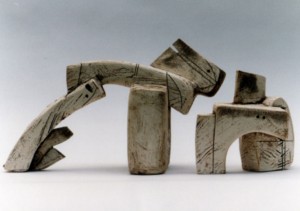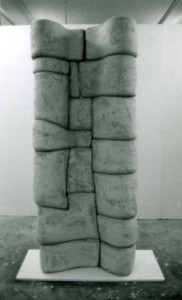Michael Mason is an artist who lives and breathes Sculpture. Having spent much time in Venezuela and Croatia, his work is reminiscent of his travels and artistic experiences. Mason uses largely bronze and ceramics; his work has a solidity and presence about it that has a calming strength. His ‘old school’ approach to his work stubbornly stands in defiance to todays’ fashionable contemporary and conceptual Art.
Mason’s sculptures are both wonderfully envisioned and executed, they have a craftsmanship rarely seen in today’s studios or art departments, an element in Art that, by today’s standards, can be somewhat absent, but gratefully received.
Mason frequently exhibits around the UK, largely in the North-West. He is a former winner of the Haywood Prize from the Royal Manchester Institution, in 2008, he won the Norweb Prize MC Acad. Alongside working and creating in his studio, Mason spends time teaching Tai Chi and a dedicated reader of Lao Tsu.
In His Own Words
Could you please introduce yourself and tell us a bit about your background and how you choose Sculpture over other Fine Art disciplines.
I was born in Lancashire in 1935 and up to the age of twenty lived in thirty-seven different locations. These were mainly in the foothills of the Pennines, this was partly to gain respite from the Luftwaffe and partly to satisfy my mother’s wanderlust.
Two events were important in my early years the first was when I was six years old I did a drawing of my mother ice skating, something she never did, but in the drawing I managed to make her look as if she was moving very fast. I was so thrilled with this I made up my mind there and then to be an artist of some sort or other.
The second was the 1944 education act, I always claim that I am a product of this act. I took my eleven plus examination using a pencil ( a great innovation of the time as prior to this it was steel nib and dip in inkwell) and secured a place at Audenshaw Grammar School. We had a great art teacher and this combined with my father’s interest in my education,( he was always finding people to teach me things like puppet making, woodcarving, model making and drawing,) pointed me even more in the direction of a career in art. In those days this meant a commercial artist in an advertising studio. So at the age of sixteen I got a job in an advertising agency attending Art School part -time. Eventually my father realised that I wanted to get a better training and so fixed up for me to attend full time at the local Art School. Here I discovered modelling and carving and after two years transferred to the Sculpture School at Manchester College of Art.
After gaining First Class honours in Sculpture and Ceramics I worked for a family of sculptors doing work for the many Roman Catholic churches being built after the war. I was also doing a bit of teaching in the evenings and eventually got a full -time lecturer’s job at Northwich School of Art. In the early sixties I moved to be Principal Lecturer in sculpture at my former college in Manchester.
In 1976 I was Fellow in Sculpture at the British School at Rome, which enabled me during that year to gain a wider understanding of classical painting and sculpture. On my return I exhibited more of my work abroad and I won the Titograd Prize in a competition in Zagreb. This led to invitations to run workshops in Venezuela and Croatia, which I did for several years and found in doing so these places stimulated various aspects of my work.
A brief selection of exhibitions.-
- The British Art Show, Arts Council.
- Art Spectrum North Arts Council.
- Wood Yorkshire Sculpture Park.
- Twentieth Century Drawings, V&A London.
- Sculpture at Tatton Gardens .N.W. Arts
- Sculpture in the Botanic Gardens Edinburgh.
- Sculpture at the Whitworth.
- Serpentine Gallery London. Arts Council.
- Peterloo Gallery Manchester.
- Asociacion Venezolana de las Artes del Fuego Caracas
- Gallerie Bass Caracas.
- Mostra Rome British Council.
- Museum of Modern Art Zagreb IV World Triennale Zagreb.
- Romanticism and New Landscapes in Art ,Southern Arts
- The Study Gallery Dorset.
- Bloomberg Space London.
Collections-
- Arts Council G.B.
- Victoria and Albert Museum, London.
- A.V.A.F. Caracas.
- Arte Fuego El Hatillo.
- Juan Carlos Lancara Venezuela.

100 years (Collection of Juan Carlos Lancara, Venezuela) Dimensions: Dimensions variable Materials: Ceramic
Over the years what elements in your work do you find most challenging and what influences have driven your work and why?
The elements that I have found most challenging when I am working in Ceramics or Terracotta have been those of scale everything is determined by the size of my kiln and consequently work has to be sectional to achieve mass. Influences are probably much to do with travel, we have worked extensively in Venezuela ,Croatia and Italy and I find aspects and attitudes feed into some of my imagery. I see parallels between things such as adobe blockwork and Etruscan masonry, which give me ideas for structures in my sculpture. I’m also impressed by the wild and exotic places I visit like the Llanos in South America where life and death are always in the balance.
You worked for a long time as a senior lecturer in Sculpture . Do you think that lecturing, teaching and working in such a large Fine Art department effected your own personal work, if so how?
True I did work in the sculpture department for a long time this gives you something to rub up against. People who give you ideas and others whose ideas are interesting but not yours. I enjoyed working with Mike Lyons we had much in common even though we worked in different materials. Teaching I’ve always found both a distraction and something which keeps you on your toes. There are some groups of students who are so bright that you have to bone up on your knowledge to keep up with them and there are others who keep on inventing the wheel either way I’ve always liked most of my students.
You’re married to a painter. Do you share a studio or do you work very much independently. What are the benefits and effects of being married to another artist?
Yes I’ve been married for over fifty years Barbara is a painter, an oil painter, whose work has parallels to mine without being the same. We have separate studios and keep to our own ways of working, we do not trespass on each others territory and this way we keep the peace. We discuss each others work and often wake up in the morning talking about some aspect or other of art in general or each others work.
You’ve been an artist for a long time and use traditional sculptural materials such as ceramic and bronze. How do you continue to grow and develop yourself and your ideas? Do you reinvent yourself regularly or continue to develop former concepts. Thinking of this, what advice do you have for younger emerging artists out there?
How do I grow and develop well I’ve got to be nearly eighty so I guess I manage somehow but I know what you’re getting at. I used to be concerned with keeping up with trends not particularly to influence my work just to keep up to date for teaching. Nowadays I think there is a great danger in striving to be trendy I even think that if you strive to be original you sure will fail. Originality I think comes from outside; from something which excites your senses, or something which happens to you and this could be happy or tragic but it’s not a thing you can force. Hope this doesn’t sound too fatalistic or hippy but I must confess I do read Lao Tsu fairly regularly. I suppose I put more emphasis on interpretation than ideas- ideas are two a penny- its what you do with them that counts.
Advice for others well should I be so presumptuous? The best I can manage here is enjoy what you do and don’t worry what other people think about the outcome so long as you are not fooling yourself.
Michael Mason is a former Principal Lecturer at Manchester Metropolitan University. He won a fellowship in Sculpture at The British School at Rome and has worked extensively on overseas projects, principally in Venezuela and Croatia. Presently he works from his studio in Somerset.
All images courtesy of Michael Mason, FRBS | www.rbs.org.uk/artists/michael-mason
For more information on Hong Kong Art Tutoring please contact:
Gail Deayton
Telephone: +852 9722 8353
Email: gd@gaildeayton.com




